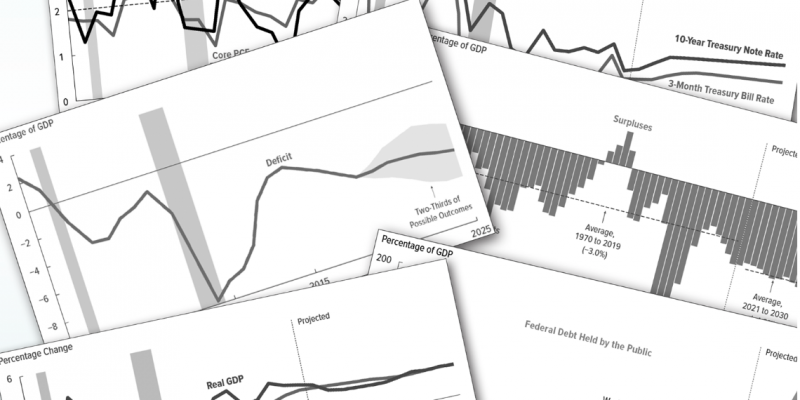The latest Congressional Budget Office (CBO) report projects that the federal debt will grow to 98 percent of GDP by 2030, with the economy expanding at an average annual rate of 1.7 percent from 2021 to 2030.
CBO estimates a 2020 deficit of $1 trillion, or 4.6 percent of GDP. The projected gap between spending and revenue increases to 5.4 percent of GDP in 2030. Federal debt held by the public is projected to rise over the coming decade, CBO reports, from 81 percent of GDP in 2020 to 98 percent of GDP in 2030 – its highest percentage since 1946.
If no changes are made and spending and borrowing continue along the same path, CBO projects federal debt held by the public will reach 180 percent of GDP in 2050, “well above the highest level ever recorded in the United States.”
The nonpartisan agency regularly publishes reports covering projections about the federal deficits, debt, revenues, and spending, and the overall economy based on current laws governing taxes and spending.
This latest shows a cumulative 10-year deficit that is slightly larger and a cumulative 30-year deficit that is notably larger than those in CBO’s previous projections, the authors of the report state.
“Other than a six-year period during and immediately after World War II, the deficit over the past century has not exceeded 4 percent for more than five consecutive years,” the report states. “And during the past 50 years, deficits have averaged 1.5 percent of GDP when the economy was relatively strong (as it is now).”
Michael Peterson, CEO of the Peter G. Peterson Foundation, told The Center Square, “Today’s CBO report shows ten straight years of trillion-dollar deficits. That’s a sad reflection of our nation’s poor fiscal health, and it adds insult to injury that we’re piling on all this debt in a growing economy.
“It’s important to recognize that it’s not just the large amount of deficit spending that’s a problem, it’s that we are borrowing for current consumption rather than investments,” Peterson added. “It would be one thing if we were running up deficits to fund investments in the future, but that’s not what’s happening. Investments are only a tiny fraction of the base budget and are not driving the deficit increases in this outlook.”
CBO’s estimate of the deficit for 2020 is now $8 billion more than its prediction six months ago. CBO’s projection of the cumulative deficit over the 2020–2029 period is now also $160 billion more than it project in August 2019.
“That 10-year increase is the net result of changes that go in opposite directions,” it states. “Lower projected interest rates and higher estimates of wages, salaries, and proprietors’ income reduced projected deficits, but a combination of recent legislation and other changes increased them.”
Since the CBO’s long-term budget projection published in June 2019, it now projects that debt held by the public as a percentage of GDP will be 30 percent higher in 2049.
“High and rising federal debt would reduce national saving and income, boost the government’s interest payments, limit policymakers’ ability to respond to unforeseen events, and increase the likelihood of a fiscal crisis,” CBO reports.
This article was first published by The Center Square.
Advertisement
Advertisement

